Analysis of Stormwater Pollutants and Sediment in Darwin, NT
VerifiedAdded on 2020/11/23
|35
|11010
|121
Report
AI Summary
This report provides a comprehensive analysis of stormwater management, focusing on the reduction of pollutants and sediment in stormwater drains, specifically in the context of Darwin, Northern Territory. The study begins with an introduction outlining the importance of clean stormwater and the environmental challenges posed by pollution. It then delves into the existing regulatory and governance frameworks, practices of municipal, state, and federal governments, and the advantages and disadvantages of current systems. The report utilizes secondary research to identify and analyze strategies employed to mitigate pollutants and sedimentation. The research methodology, including research philosophy, approach, design, and strategy, is thoroughly detailed. The findings highlight the significance of stormwater management, the impact of pollutants on the environment, and the effectiveness of current interventions. The report concludes with recommendations to enhance existing practices, contributing to improved water quality and the preservation of aquatic ecosystems in the Darwin Harbour. The structure includes an introduction, literature review, research methodology, and data analysis, ensuring a systematic and structured approach to the subject matter.
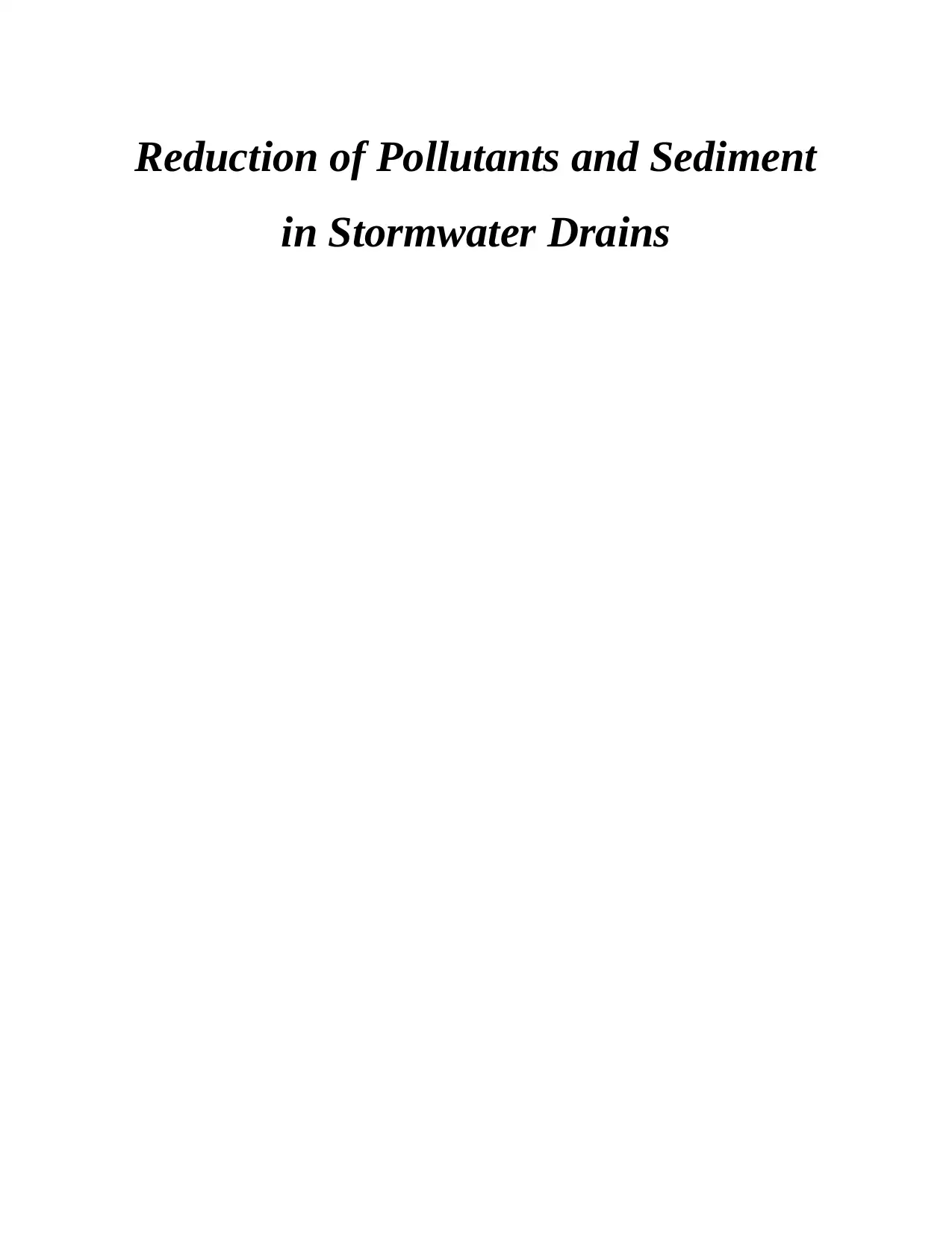
Reduction of Pollutants and Sediment
in Stormwater Drains
in Stormwater Drains
Paraphrase This Document
Need a fresh take? Get an instant paraphrase of this document with our AI Paraphraser
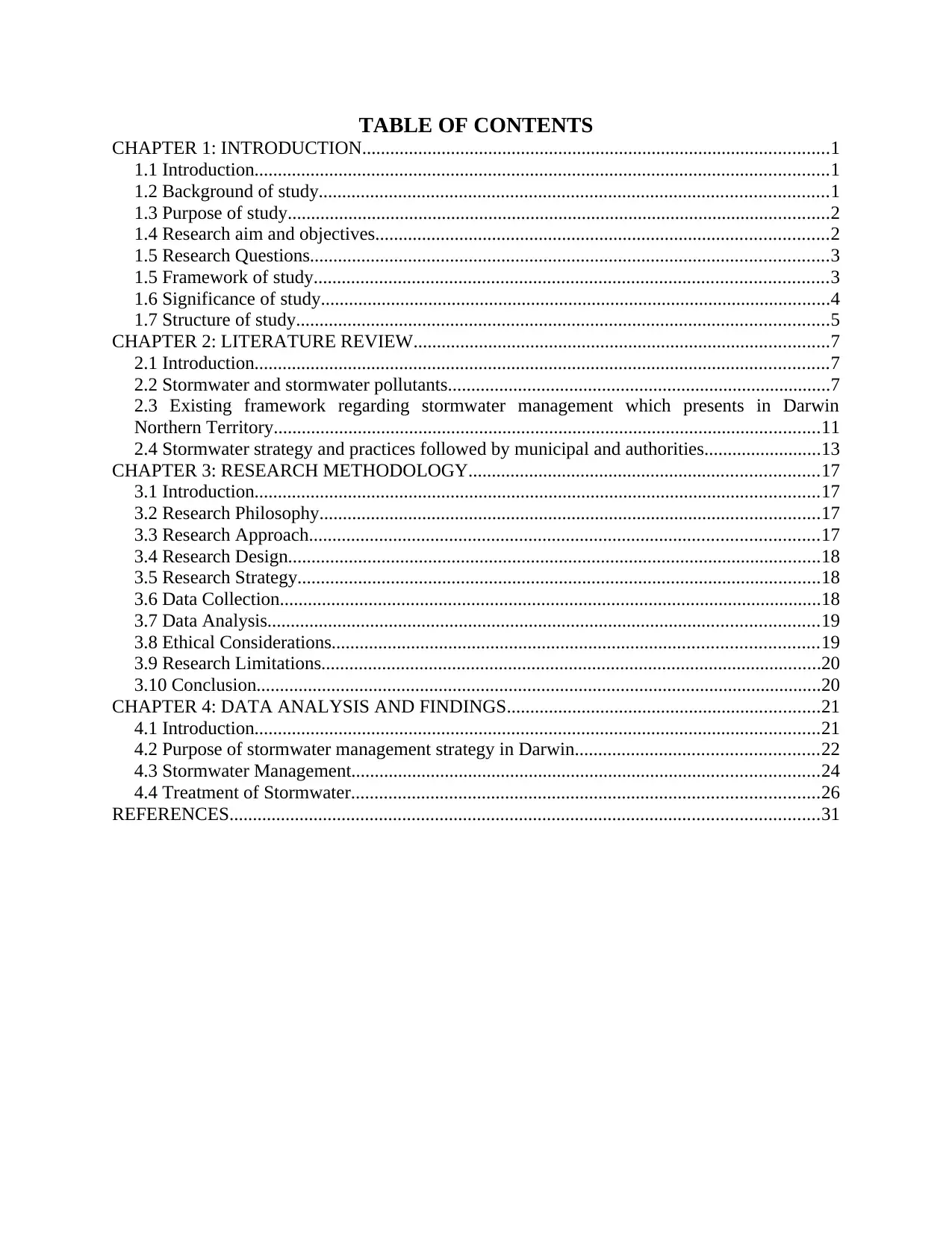
TABLE OF CONTENTS
CHAPTER 1: INTRODUCTION....................................................................................................1
1.1 Introduction...........................................................................................................................1
1.2 Background of study.............................................................................................................1
1.3 Purpose of study....................................................................................................................2
1.4 Research aim and objectives.................................................................................................2
1.5 Research Questions...............................................................................................................3
1.5 Framework of study..............................................................................................................3
1.6 Significance of study.............................................................................................................4
1.7 Structure of study..................................................................................................................5
CHAPTER 2: LITERATURE REVIEW.........................................................................................7
2.1 Introduction...........................................................................................................................7
2.2 Stormwater and stormwater pollutants..................................................................................7
2.3 Existing framework regarding stormwater management which presents in Darwin
Northern Territory.....................................................................................................................11
2.4 Stormwater strategy and practices followed by municipal and authorities.........................13
CHAPTER 3: RESEARCH METHODOLOGY...........................................................................17
3.1 Introduction.........................................................................................................................17
3.2 Research Philosophy...........................................................................................................17
3.3 Research Approach.............................................................................................................17
3.4 Research Design..................................................................................................................18
3.5 Research Strategy................................................................................................................18
3.6 Data Collection....................................................................................................................18
3.7 Data Analysis......................................................................................................................19
3.8 Ethical Considerations........................................................................................................19
3.9 Research Limitations...........................................................................................................20
3.10 Conclusion.........................................................................................................................20
CHAPTER 4: DATA ANALYSIS AND FINDINGS...................................................................21
4.1 Introduction.........................................................................................................................21
4.2 Purpose of stormwater management strategy in Darwin....................................................22
4.3 Stormwater Management....................................................................................................24
4.4 Treatment of Stormwater....................................................................................................26
REFERENCES..............................................................................................................................31
CHAPTER 1: INTRODUCTION....................................................................................................1
1.1 Introduction...........................................................................................................................1
1.2 Background of study.............................................................................................................1
1.3 Purpose of study....................................................................................................................2
1.4 Research aim and objectives.................................................................................................2
1.5 Research Questions...............................................................................................................3
1.5 Framework of study..............................................................................................................3
1.6 Significance of study.............................................................................................................4
1.7 Structure of study..................................................................................................................5
CHAPTER 2: LITERATURE REVIEW.........................................................................................7
2.1 Introduction...........................................................................................................................7
2.2 Stormwater and stormwater pollutants..................................................................................7
2.3 Existing framework regarding stormwater management which presents in Darwin
Northern Territory.....................................................................................................................11
2.4 Stormwater strategy and practices followed by municipal and authorities.........................13
CHAPTER 3: RESEARCH METHODOLOGY...........................................................................17
3.1 Introduction.........................................................................................................................17
3.2 Research Philosophy...........................................................................................................17
3.3 Research Approach.............................................................................................................17
3.4 Research Design..................................................................................................................18
3.5 Research Strategy................................................................................................................18
3.6 Data Collection....................................................................................................................18
3.7 Data Analysis......................................................................................................................19
3.8 Ethical Considerations........................................................................................................19
3.9 Research Limitations...........................................................................................................20
3.10 Conclusion.........................................................................................................................20
CHAPTER 4: DATA ANALYSIS AND FINDINGS...................................................................21
4.1 Introduction.........................................................................................................................21
4.2 Purpose of stormwater management strategy in Darwin....................................................22
4.3 Stormwater Management....................................................................................................24
4.4 Treatment of Stormwater....................................................................................................26
REFERENCES..............................................................................................................................31
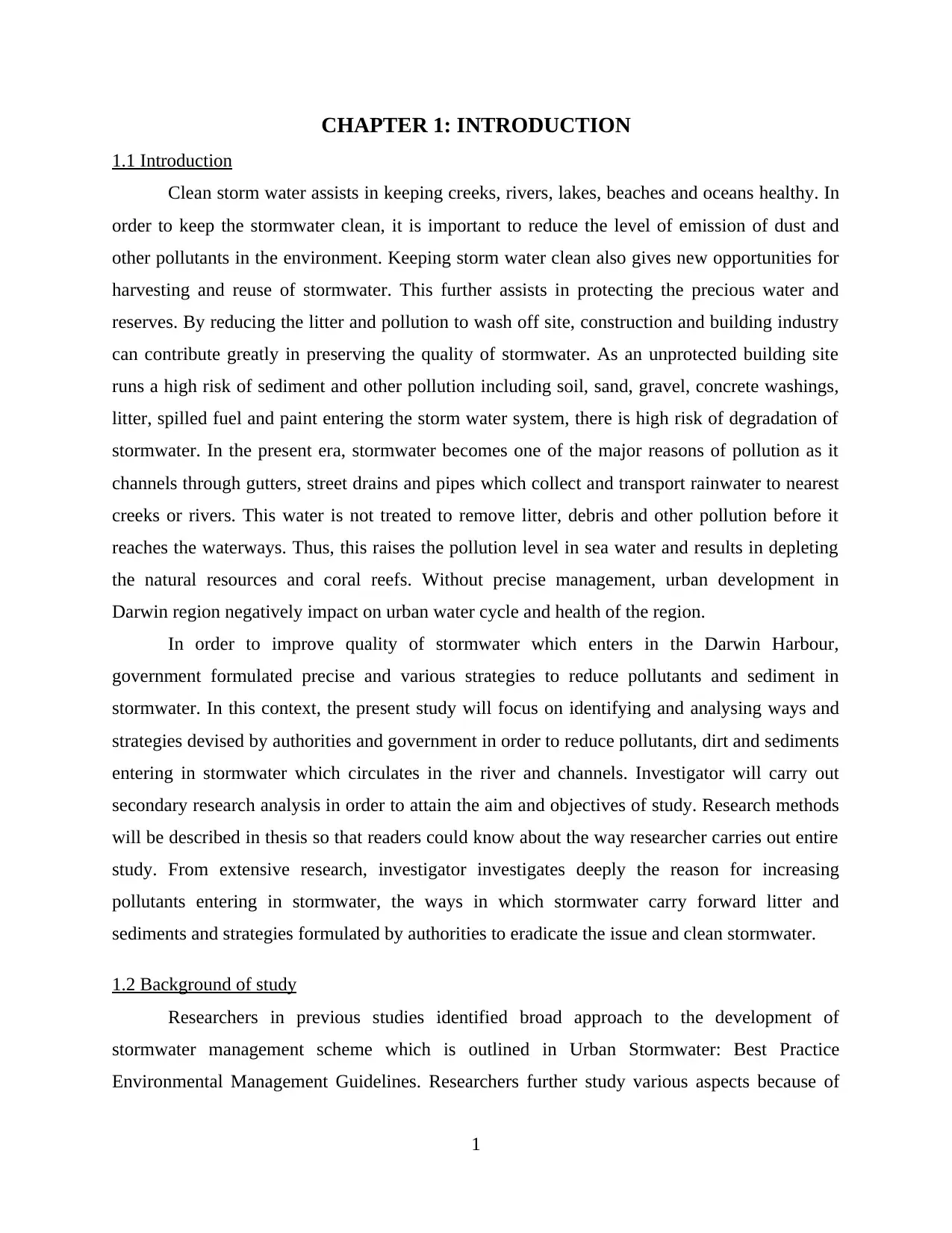
CHAPTER 1: INTRODUCTION
1.1 Introduction
Clean storm water assists in keeping creeks, rivers, lakes, beaches and oceans healthy. In
order to keep the stormwater clean, it is important to reduce the level of emission of dust and
other pollutants in the environment. Keeping storm water clean also gives new opportunities for
harvesting and reuse of stormwater. This further assists in protecting the precious water and
reserves. By reducing the litter and pollution to wash off site, construction and building industry
can contribute greatly in preserving the quality of stormwater. As an unprotected building site
runs a high risk of sediment and other pollution including soil, sand, gravel, concrete washings,
litter, spilled fuel and paint entering the storm water system, there is high risk of degradation of
stormwater. In the present era, stormwater becomes one of the major reasons of pollution as it
channels through gutters, street drains and pipes which collect and transport rainwater to nearest
creeks or rivers. This water is not treated to remove litter, debris and other pollution before it
reaches the waterways. Thus, this raises the pollution level in sea water and results in depleting
the natural resources and coral reefs. Without precise management, urban development in
Darwin region negatively impact on urban water cycle and health of the region.
In order to improve quality of stormwater which enters in the Darwin Harbour,
government formulated precise and various strategies to reduce pollutants and sediment in
stormwater. In this context, the present study will focus on identifying and analysing ways and
strategies devised by authorities and government in order to reduce pollutants, dirt and sediments
entering in stormwater which circulates in the river and channels. Investigator will carry out
secondary research analysis in order to attain the aim and objectives of study. Research methods
will be described in thesis so that readers could know about the way researcher carries out entire
study. From extensive research, investigator investigates deeply the reason for increasing
pollutants entering in stormwater, the ways in which stormwater carry forward litter and
sediments and strategies formulated by authorities to eradicate the issue and clean stormwater.
1.2 Background of study
Researchers in previous studies identified broad approach to the development of
stormwater management scheme which is outlined in Urban Stormwater: Best Practice
Environmental Management Guidelines. Researchers further study various aspects because of
1
1.1 Introduction
Clean storm water assists in keeping creeks, rivers, lakes, beaches and oceans healthy. In
order to keep the stormwater clean, it is important to reduce the level of emission of dust and
other pollutants in the environment. Keeping storm water clean also gives new opportunities for
harvesting and reuse of stormwater. This further assists in protecting the precious water and
reserves. By reducing the litter and pollution to wash off site, construction and building industry
can contribute greatly in preserving the quality of stormwater. As an unprotected building site
runs a high risk of sediment and other pollution including soil, sand, gravel, concrete washings,
litter, spilled fuel and paint entering the storm water system, there is high risk of degradation of
stormwater. In the present era, stormwater becomes one of the major reasons of pollution as it
channels through gutters, street drains and pipes which collect and transport rainwater to nearest
creeks or rivers. This water is not treated to remove litter, debris and other pollution before it
reaches the waterways. Thus, this raises the pollution level in sea water and results in depleting
the natural resources and coral reefs. Without precise management, urban development in
Darwin region negatively impact on urban water cycle and health of the region.
In order to improve quality of stormwater which enters in the Darwin Harbour,
government formulated precise and various strategies to reduce pollutants and sediment in
stormwater. In this context, the present study will focus on identifying and analysing ways and
strategies devised by authorities and government in order to reduce pollutants, dirt and sediments
entering in stormwater which circulates in the river and channels. Investigator will carry out
secondary research analysis in order to attain the aim and objectives of study. Research methods
will be described in thesis so that readers could know about the way researcher carries out entire
study. From extensive research, investigator investigates deeply the reason for increasing
pollutants entering in stormwater, the ways in which stormwater carry forward litter and
sediments and strategies formulated by authorities to eradicate the issue and clean stormwater.
1.2 Background of study
Researchers in previous studies identified broad approach to the development of
stormwater management scheme which is outlined in Urban Stormwater: Best Practice
Environmental Management Guidelines. Researchers further study various aspects because of
1
⊘ This is a preview!⊘
Do you want full access?
Subscribe today to unlock all pages.

Trusted by 1+ million students worldwide
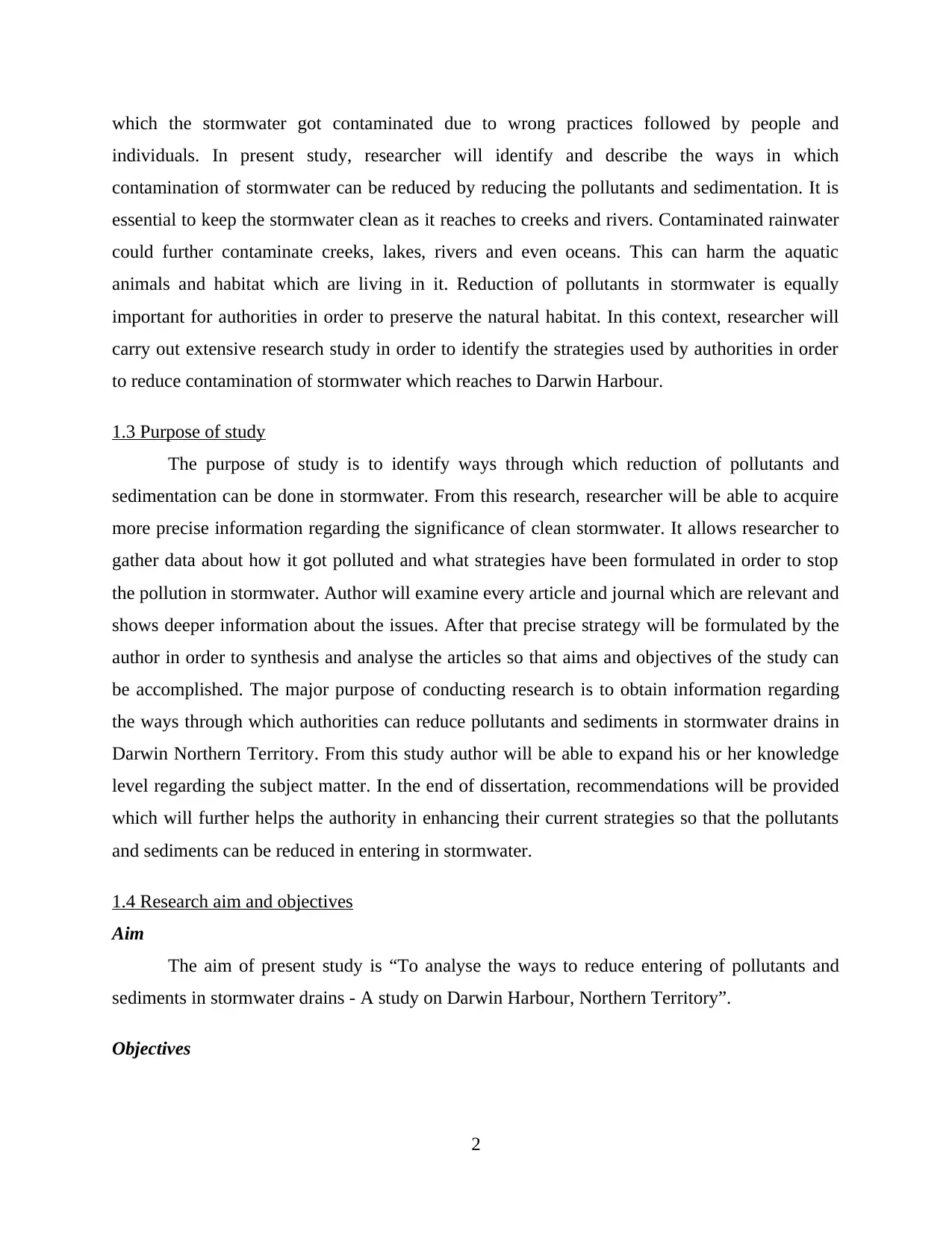
which the stormwater got contaminated due to wrong practices followed by people and
individuals. In present study, researcher will identify and describe the ways in which
contamination of stormwater can be reduced by reducing the pollutants and sedimentation. It is
essential to keep the stormwater clean as it reaches to creeks and rivers. Contaminated rainwater
could further contaminate creeks, lakes, rivers and even oceans. This can harm the aquatic
animals and habitat which are living in it. Reduction of pollutants in stormwater is equally
important for authorities in order to preserve the natural habitat. In this context, researcher will
carry out extensive research study in order to identify the strategies used by authorities in order
to reduce contamination of stormwater which reaches to Darwin Harbour.
1.3 Purpose of study
The purpose of study is to identify ways through which reduction of pollutants and
sedimentation can be done in stormwater. From this research, researcher will be able to acquire
more precise information regarding the significance of clean stormwater. It allows researcher to
gather data about how it got polluted and what strategies have been formulated in order to stop
the pollution in stormwater. Author will examine every article and journal which are relevant and
shows deeper information about the issues. After that precise strategy will be formulated by the
author in order to synthesis and analyse the articles so that aims and objectives of the study can
be accomplished. The major purpose of conducting research is to obtain information regarding
the ways through which authorities can reduce pollutants and sediments in stormwater drains in
Darwin Northern Territory. From this study author will be able to expand his or her knowledge
level regarding the subject matter. In the end of dissertation, recommendations will be provided
which will further helps the authority in enhancing their current strategies so that the pollutants
and sediments can be reduced in entering in stormwater.
1.4 Research aim and objectives
Aim
The aim of present study is “To analyse the ways to reduce entering of pollutants and
sediments in stormwater drains - A study on Darwin Harbour, Northern Territory”.
Objectives
2
individuals. In present study, researcher will identify and describe the ways in which
contamination of stormwater can be reduced by reducing the pollutants and sedimentation. It is
essential to keep the stormwater clean as it reaches to creeks and rivers. Contaminated rainwater
could further contaminate creeks, lakes, rivers and even oceans. This can harm the aquatic
animals and habitat which are living in it. Reduction of pollutants in stormwater is equally
important for authorities in order to preserve the natural habitat. In this context, researcher will
carry out extensive research study in order to identify the strategies used by authorities in order
to reduce contamination of stormwater which reaches to Darwin Harbour.
1.3 Purpose of study
The purpose of study is to identify ways through which reduction of pollutants and
sedimentation can be done in stormwater. From this research, researcher will be able to acquire
more precise information regarding the significance of clean stormwater. It allows researcher to
gather data about how it got polluted and what strategies have been formulated in order to stop
the pollution in stormwater. Author will examine every article and journal which are relevant and
shows deeper information about the issues. After that precise strategy will be formulated by the
author in order to synthesis and analyse the articles so that aims and objectives of the study can
be accomplished. The major purpose of conducting research is to obtain information regarding
the ways through which authorities can reduce pollutants and sediments in stormwater drains in
Darwin Northern Territory. From this study author will be able to expand his or her knowledge
level regarding the subject matter. In the end of dissertation, recommendations will be provided
which will further helps the authority in enhancing their current strategies so that the pollutants
and sediments can be reduced in entering in stormwater.
1.4 Research aim and objectives
Aim
The aim of present study is “To analyse the ways to reduce entering of pollutants and
sediments in stormwater drains - A study on Darwin Harbour, Northern Territory”.
Objectives
2
Paraphrase This Document
Need a fresh take? Get an instant paraphrase of this document with our AI Paraphraser
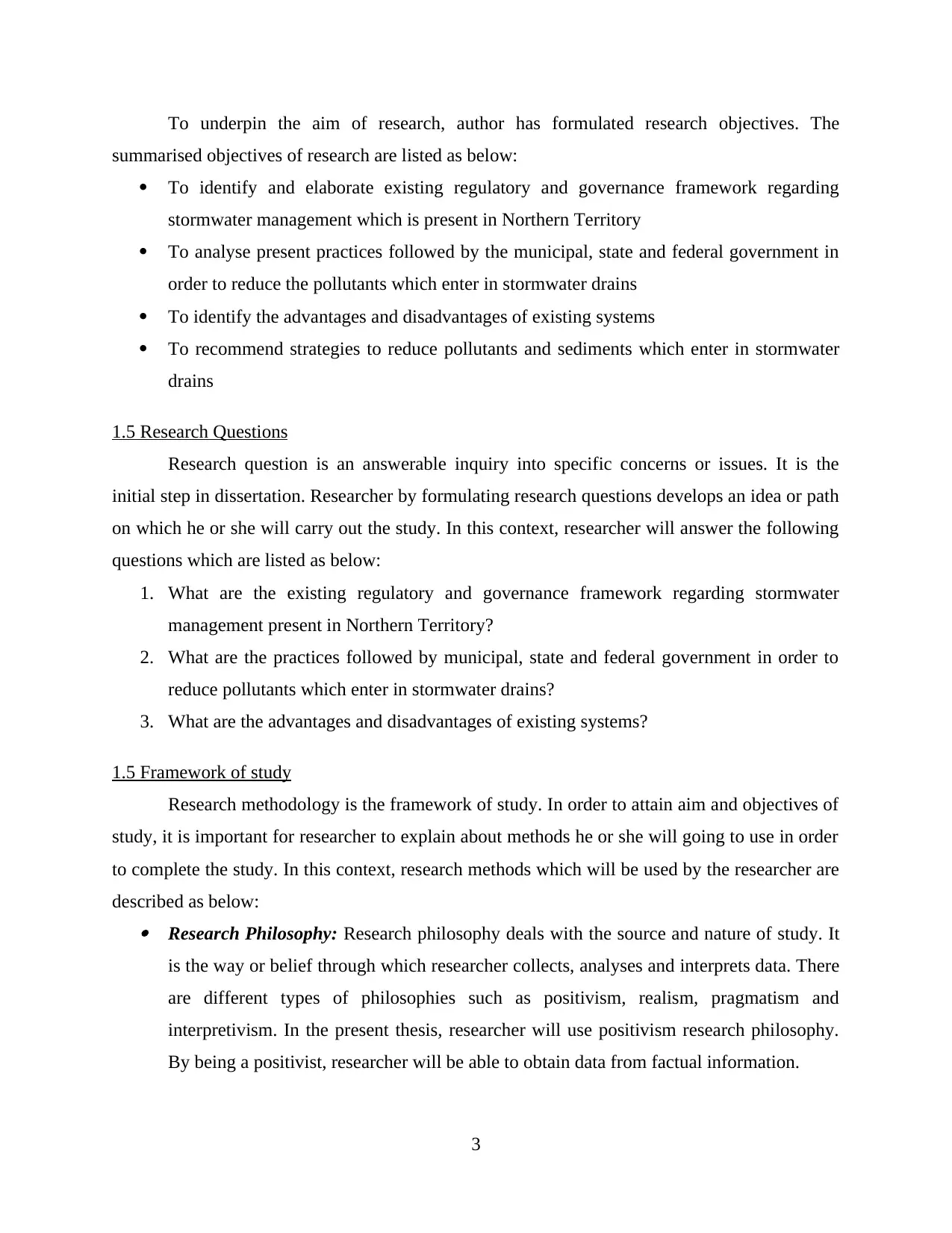
To underpin the aim of research, author has formulated research objectives. The
summarised objectives of research are listed as below:
To identify and elaborate existing regulatory and governance framework regarding
stormwater management which is present in Northern Territory
To analyse present practices followed by the municipal, state and federal government in
order to reduce the pollutants which enter in stormwater drains
To identify the advantages and disadvantages of existing systems
To recommend strategies to reduce pollutants and sediments which enter in stormwater
drains
1.5 Research Questions
Research question is an answerable inquiry into specific concerns or issues. It is the
initial step in dissertation. Researcher by formulating research questions develops an idea or path
on which he or she will carry out the study. In this context, researcher will answer the following
questions which are listed as below:
1. What are the existing regulatory and governance framework regarding stormwater
management present in Northern Territory?
2. What are the practices followed by municipal, state and federal government in order to
reduce pollutants which enter in stormwater drains?
3. What are the advantages and disadvantages of existing systems?
1.5 Framework of study
Research methodology is the framework of study. In order to attain aim and objectives of
study, it is important for researcher to explain about methods he or she will going to use in order
to complete the study. In this context, research methods which will be used by the researcher are
described as below: Research Philosophy: Research philosophy deals with the source and nature of study. It
is the way or belief through which researcher collects, analyses and interprets data. There
are different types of philosophies such as positivism, realism, pragmatism and
interpretivism. In the present thesis, researcher will use positivism research philosophy.
By being a positivist, researcher will be able to obtain data from factual information.
3
summarised objectives of research are listed as below:
To identify and elaborate existing regulatory and governance framework regarding
stormwater management which is present in Northern Territory
To analyse present practices followed by the municipal, state and federal government in
order to reduce the pollutants which enter in stormwater drains
To identify the advantages and disadvantages of existing systems
To recommend strategies to reduce pollutants and sediments which enter in stormwater
drains
1.5 Research Questions
Research question is an answerable inquiry into specific concerns or issues. It is the
initial step in dissertation. Researcher by formulating research questions develops an idea or path
on which he or she will carry out the study. In this context, researcher will answer the following
questions which are listed as below:
1. What are the existing regulatory and governance framework regarding stormwater
management present in Northern Territory?
2. What are the practices followed by municipal, state and federal government in order to
reduce pollutants which enter in stormwater drains?
3. What are the advantages and disadvantages of existing systems?
1.5 Framework of study
Research methodology is the framework of study. In order to attain aim and objectives of
study, it is important for researcher to explain about methods he or she will going to use in order
to complete the study. In this context, research methods which will be used by the researcher are
described as below: Research Philosophy: Research philosophy deals with the source and nature of study. It
is the way or belief through which researcher collects, analyses and interprets data. There
are different types of philosophies such as positivism, realism, pragmatism and
interpretivism. In the present thesis, researcher will use positivism research philosophy.
By being a positivist, researcher will be able to obtain data from factual information.
3
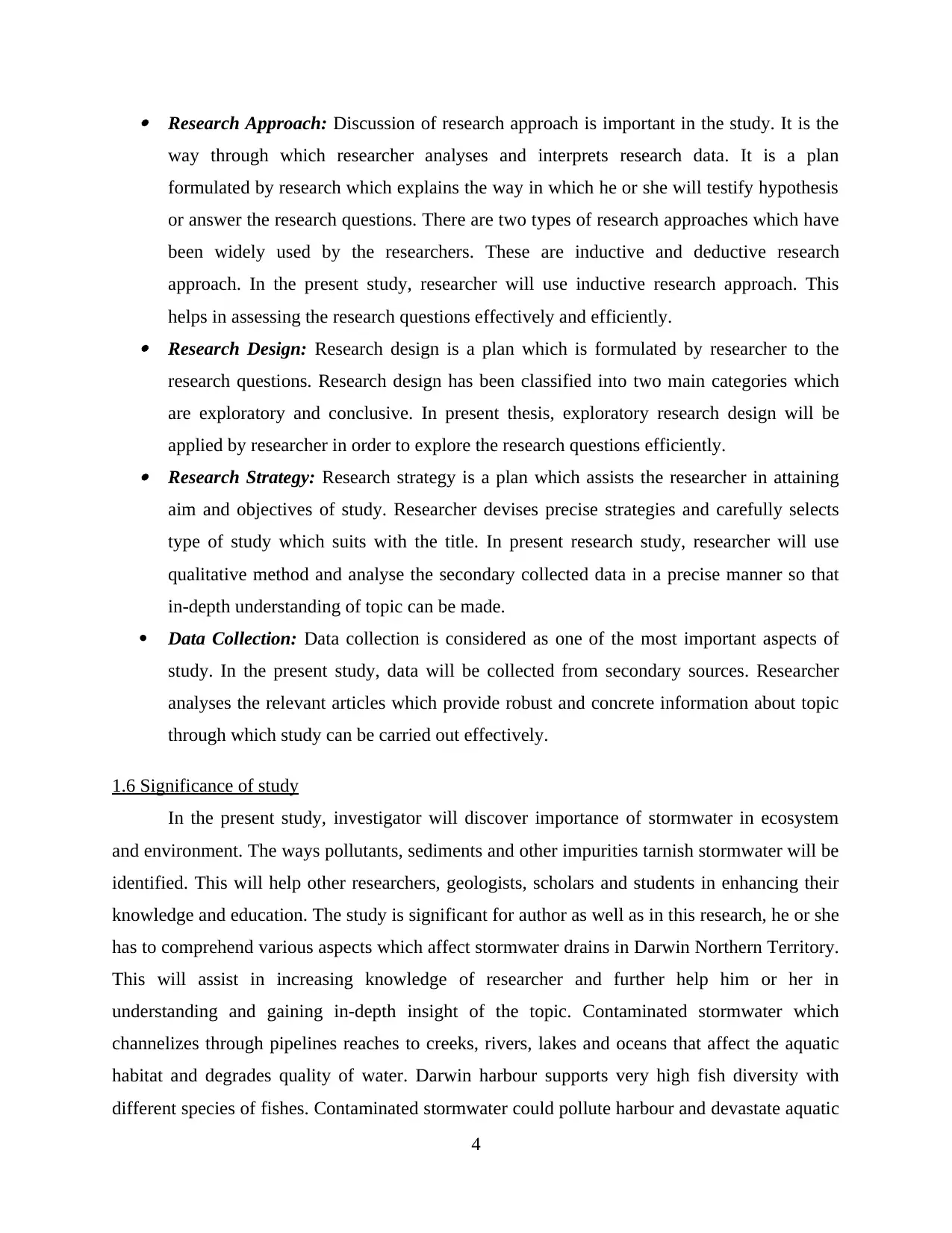
Research Approach: Discussion of research approach is important in the study. It is the
way through which researcher analyses and interprets research data. It is a plan
formulated by research which explains the way in which he or she will testify hypothesis
or answer the research questions. There are two types of research approaches which have
been widely used by the researchers. These are inductive and deductive research
approach. In the present study, researcher will use inductive research approach. This
helps in assessing the research questions effectively and efficiently. Research Design: Research design is a plan which is formulated by researcher to the
research questions. Research design has been classified into two main categories which
are exploratory and conclusive. In present thesis, exploratory research design will be
applied by researcher in order to explore the research questions efficiently. Research Strategy: Research strategy is a plan which assists the researcher in attaining
aim and objectives of study. Researcher devises precise strategies and carefully selects
type of study which suits with the title. In present research study, researcher will use
qualitative method and analyse the secondary collected data in a precise manner so that
in-depth understanding of topic can be made.
Data Collection: Data collection is considered as one of the most important aspects of
study. In the present study, data will be collected from secondary sources. Researcher
analyses the relevant articles which provide robust and concrete information about topic
through which study can be carried out effectively.
1.6 Significance of study
In the present study, investigator will discover importance of stormwater in ecosystem
and environment. The ways pollutants, sediments and other impurities tarnish stormwater will be
identified. This will help other researchers, geologists, scholars and students in enhancing their
knowledge and education. The study is significant for author as well as in this research, he or she
has to comprehend various aspects which affect stormwater drains in Darwin Northern Territory.
This will assist in increasing knowledge of researcher and further help him or her in
understanding and gaining in-depth insight of the topic. Contaminated stormwater which
channelizes through pipelines reaches to creeks, rivers, lakes and oceans that affect the aquatic
habitat and degrades quality of water. Darwin harbour supports very high fish diversity with
different species of fishes. Contaminated stormwater could pollute harbour and devastate aquatic
4
way through which researcher analyses and interprets research data. It is a plan
formulated by research which explains the way in which he or she will testify hypothesis
or answer the research questions. There are two types of research approaches which have
been widely used by the researchers. These are inductive and deductive research
approach. In the present study, researcher will use inductive research approach. This
helps in assessing the research questions effectively and efficiently. Research Design: Research design is a plan which is formulated by researcher to the
research questions. Research design has been classified into two main categories which
are exploratory and conclusive. In present thesis, exploratory research design will be
applied by researcher in order to explore the research questions efficiently. Research Strategy: Research strategy is a plan which assists the researcher in attaining
aim and objectives of study. Researcher devises precise strategies and carefully selects
type of study which suits with the title. In present research study, researcher will use
qualitative method and analyse the secondary collected data in a precise manner so that
in-depth understanding of topic can be made.
Data Collection: Data collection is considered as one of the most important aspects of
study. In the present study, data will be collected from secondary sources. Researcher
analyses the relevant articles which provide robust and concrete information about topic
through which study can be carried out effectively.
1.6 Significance of study
In the present study, investigator will discover importance of stormwater in ecosystem
and environment. The ways pollutants, sediments and other impurities tarnish stormwater will be
identified. This will help other researchers, geologists, scholars and students in enhancing their
knowledge and education. The study is significant for author as well as in this research, he or she
has to comprehend various aspects which affect stormwater drains in Darwin Northern Territory.
This will assist in increasing knowledge of researcher and further help him or her in
understanding and gaining in-depth insight of the topic. Contaminated stormwater which
channelizes through pipelines reaches to creeks, rivers, lakes and oceans that affect the aquatic
habitat and degrades quality of water. Darwin harbour supports very high fish diversity with
different species of fishes. Contaminated stormwater could pollute harbour and devastate aquatic
4
⊘ This is a preview!⊘
Do you want full access?
Subscribe today to unlock all pages.

Trusted by 1+ million students worldwide
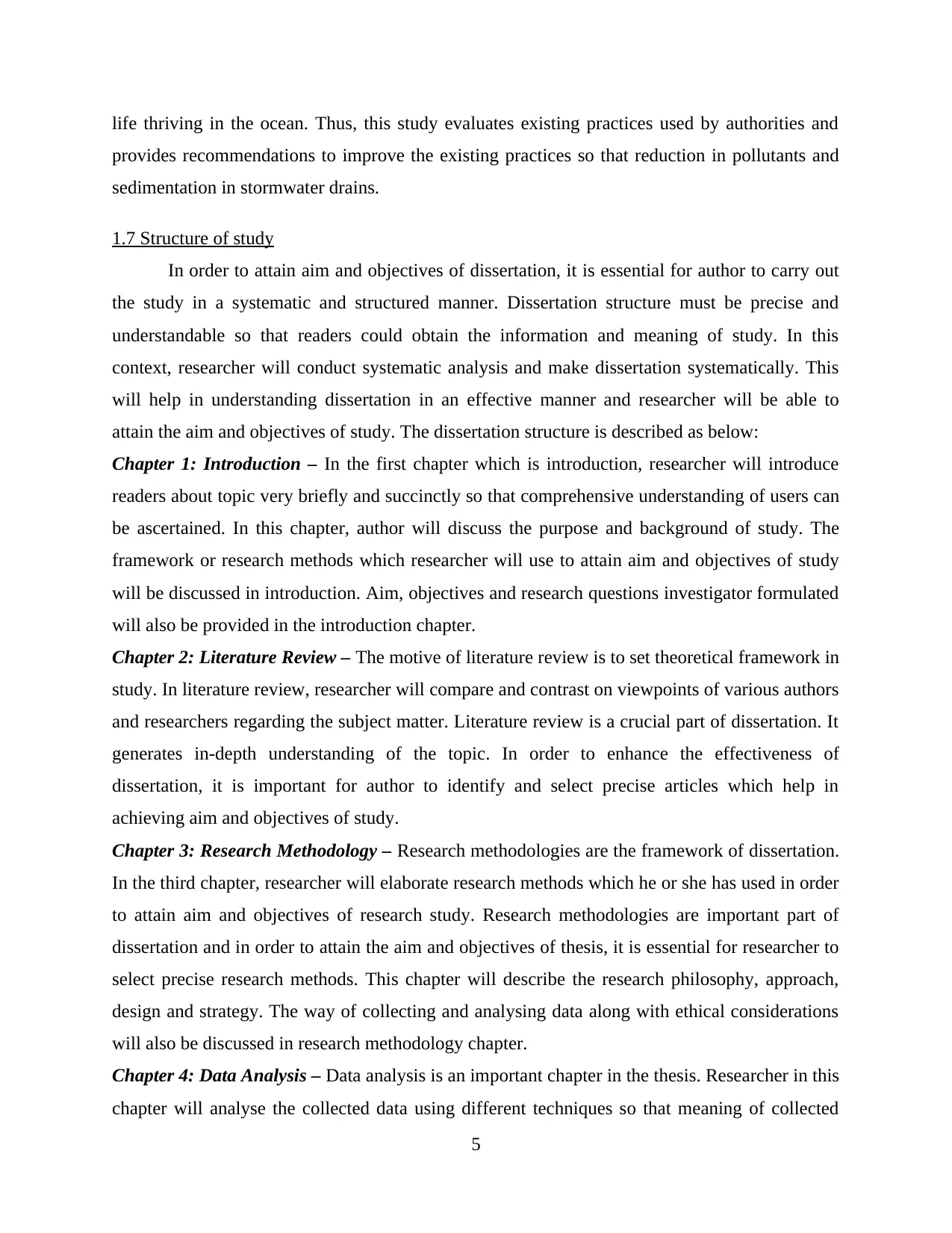
life thriving in the ocean. Thus, this study evaluates existing practices used by authorities and
provides recommendations to improve the existing practices so that reduction in pollutants and
sedimentation in stormwater drains.
1.7 Structure of study
In order to attain aim and objectives of dissertation, it is essential for author to carry out
the study in a systematic and structured manner. Dissertation structure must be precise and
understandable so that readers could obtain the information and meaning of study. In this
context, researcher will conduct systematic analysis and make dissertation systematically. This
will help in understanding dissertation in an effective manner and researcher will be able to
attain the aim and objectives of study. The dissertation structure is described as below:
Chapter 1: Introduction – In the first chapter which is introduction, researcher will introduce
readers about topic very briefly and succinctly so that comprehensive understanding of users can
be ascertained. In this chapter, author will discuss the purpose and background of study. The
framework or research methods which researcher will use to attain aim and objectives of study
will be discussed in introduction. Aim, objectives and research questions investigator formulated
will also be provided in the introduction chapter.
Chapter 2: Literature Review – The motive of literature review is to set theoretical framework in
study. In literature review, researcher will compare and contrast on viewpoints of various authors
and researchers regarding the subject matter. Literature review is a crucial part of dissertation. It
generates in-depth understanding of the topic. In order to enhance the effectiveness of
dissertation, it is important for author to identify and select precise articles which help in
achieving aim and objectives of study.
Chapter 3: Research Methodology – Research methodologies are the framework of dissertation.
In the third chapter, researcher will elaborate research methods which he or she has used in order
to attain aim and objectives of research study. Research methodologies are important part of
dissertation and in order to attain the aim and objectives of thesis, it is essential for researcher to
select precise research methods. This chapter will describe the research philosophy, approach,
design and strategy. The way of collecting and analysing data along with ethical considerations
will also be discussed in research methodology chapter.
Chapter 4: Data Analysis – Data analysis is an important chapter in the thesis. Researcher in this
chapter will analyse the collected data using different techniques so that meaning of collected
5
provides recommendations to improve the existing practices so that reduction in pollutants and
sedimentation in stormwater drains.
1.7 Structure of study
In order to attain aim and objectives of dissertation, it is essential for author to carry out
the study in a systematic and structured manner. Dissertation structure must be precise and
understandable so that readers could obtain the information and meaning of study. In this
context, researcher will conduct systematic analysis and make dissertation systematically. This
will help in understanding dissertation in an effective manner and researcher will be able to
attain the aim and objectives of study. The dissertation structure is described as below:
Chapter 1: Introduction – In the first chapter which is introduction, researcher will introduce
readers about topic very briefly and succinctly so that comprehensive understanding of users can
be ascertained. In this chapter, author will discuss the purpose and background of study. The
framework or research methods which researcher will use to attain aim and objectives of study
will be discussed in introduction. Aim, objectives and research questions investigator formulated
will also be provided in the introduction chapter.
Chapter 2: Literature Review – The motive of literature review is to set theoretical framework in
study. In literature review, researcher will compare and contrast on viewpoints of various authors
and researchers regarding the subject matter. Literature review is a crucial part of dissertation. It
generates in-depth understanding of the topic. In order to enhance the effectiveness of
dissertation, it is important for author to identify and select precise articles which help in
achieving aim and objectives of study.
Chapter 3: Research Methodology – Research methodologies are the framework of dissertation.
In the third chapter, researcher will elaborate research methods which he or she has used in order
to attain aim and objectives of research study. Research methodologies are important part of
dissertation and in order to attain the aim and objectives of thesis, it is essential for researcher to
select precise research methods. This chapter will describe the research philosophy, approach,
design and strategy. The way of collecting and analysing data along with ethical considerations
will also be discussed in research methodology chapter.
Chapter 4: Data Analysis – Data analysis is an important chapter in the thesis. Researcher in this
chapter will analyse the collected data using different techniques so that meaning of collected
5
Paraphrase This Document
Need a fresh take? Get an instant paraphrase of this document with our AI Paraphraser
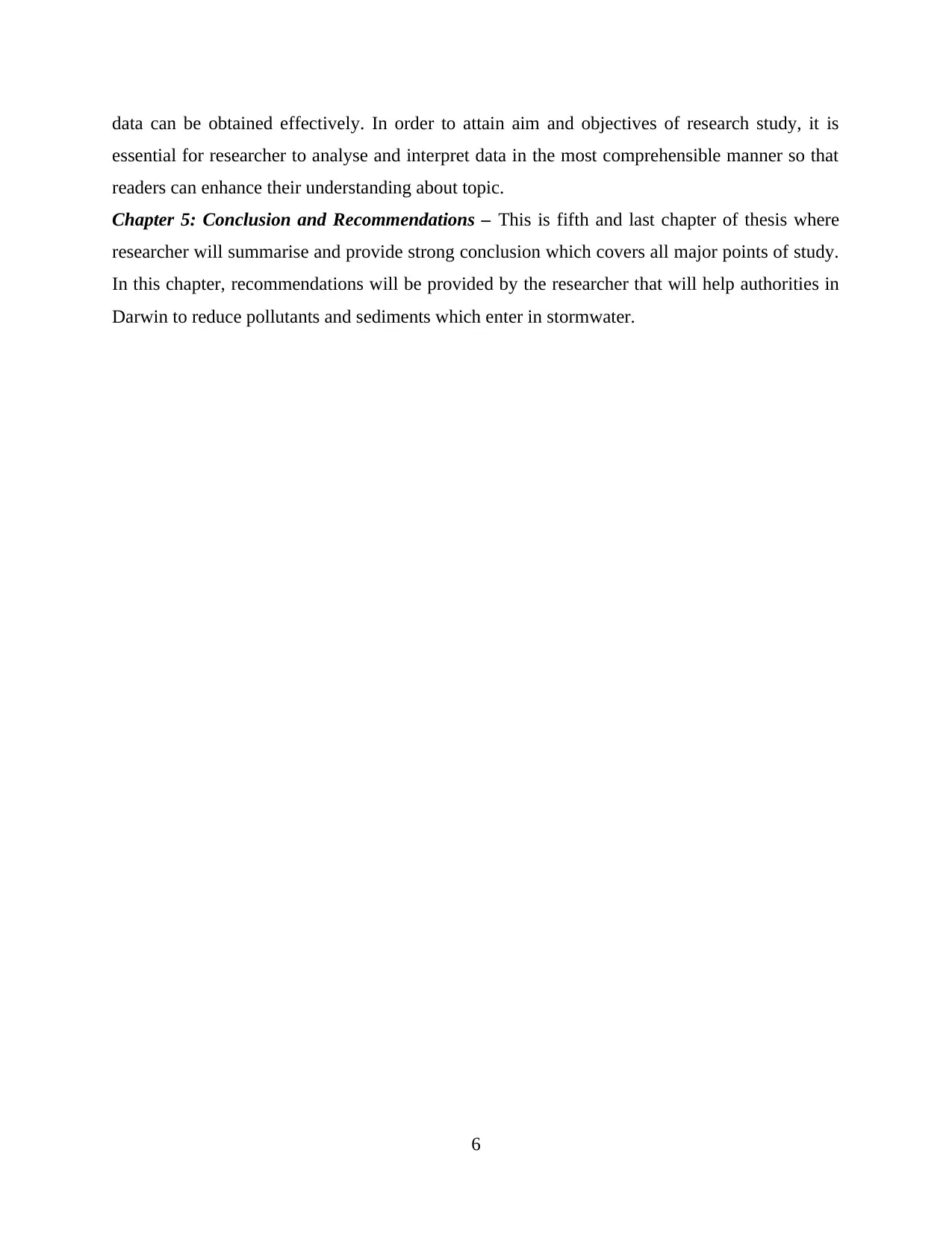
data can be obtained effectively. In order to attain aim and objectives of research study, it is
essential for researcher to analyse and interpret data in the most comprehensible manner so that
readers can enhance their understanding about topic.
Chapter 5: Conclusion and Recommendations – This is fifth and last chapter of thesis where
researcher will summarise and provide strong conclusion which covers all major points of study.
In this chapter, recommendations will be provided by the researcher that will help authorities in
Darwin to reduce pollutants and sediments which enter in stormwater.
6
essential for researcher to analyse and interpret data in the most comprehensible manner so that
readers can enhance their understanding about topic.
Chapter 5: Conclusion and Recommendations – This is fifth and last chapter of thesis where
researcher will summarise and provide strong conclusion which covers all major points of study.
In this chapter, recommendations will be provided by the researcher that will help authorities in
Darwin to reduce pollutants and sediments which enter in stormwater.
6
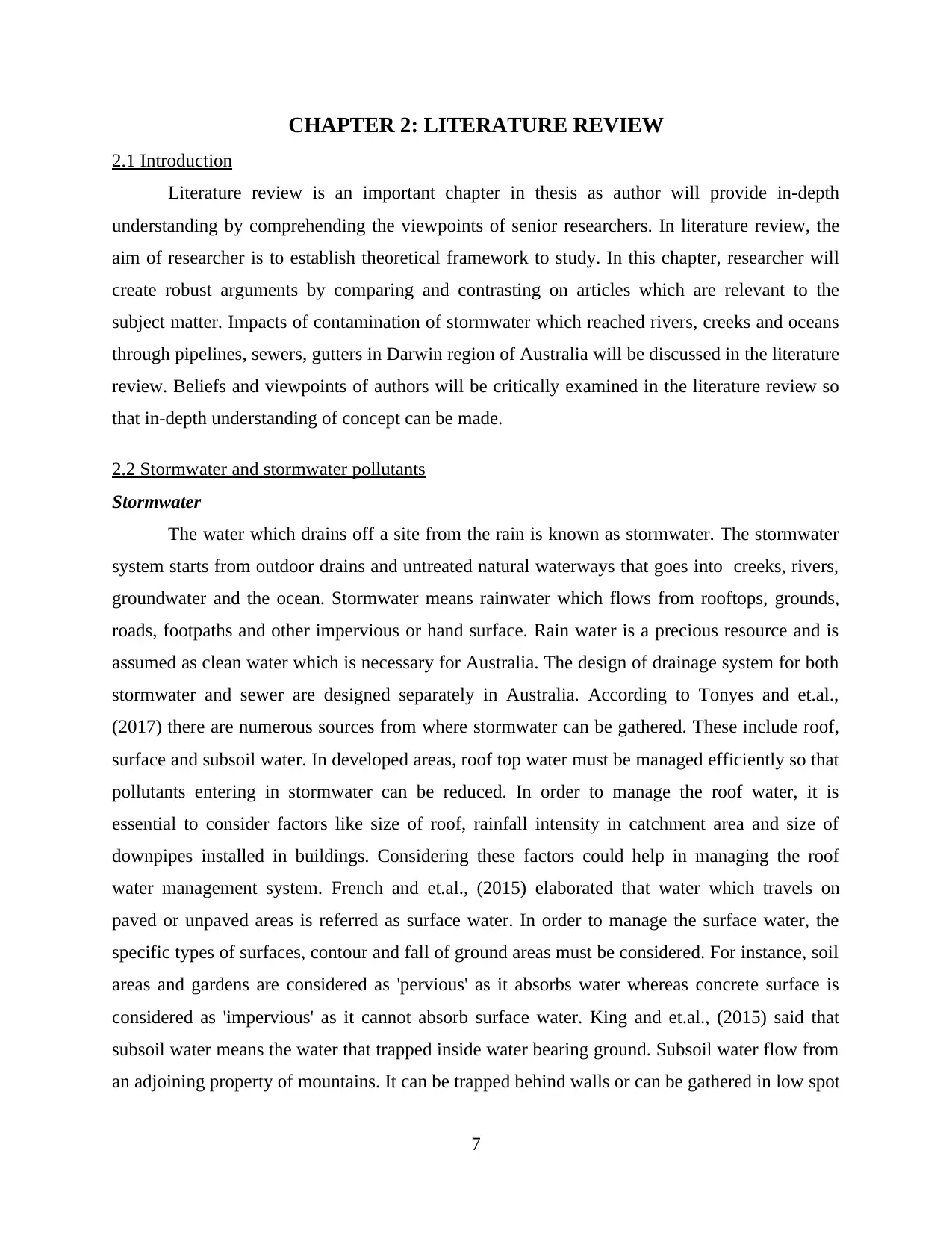
CHAPTER 2: LITERATURE REVIEW
2.1 Introduction
Literature review is an important chapter in thesis as author will provide in-depth
understanding by comprehending the viewpoints of senior researchers. In literature review, the
aim of researcher is to establish theoretical framework to study. In this chapter, researcher will
create robust arguments by comparing and contrasting on articles which are relevant to the
subject matter. Impacts of contamination of stormwater which reached rivers, creeks and oceans
through pipelines, sewers, gutters in Darwin region of Australia will be discussed in the literature
review. Beliefs and viewpoints of authors will be critically examined in the literature review so
that in-depth understanding of concept can be made.
2.2 Stormwater and stormwater pollutants
Stormwater
The water which drains off a site from the rain is known as stormwater. The stormwater
system starts from outdoor drains and untreated natural waterways that goes into creeks, rivers,
groundwater and the ocean. Stormwater means rainwater which flows from rooftops, grounds,
roads, footpaths and other impervious or hand surface. Rain water is a precious resource and is
assumed as clean water which is necessary for Australia. The design of drainage system for both
stormwater and sewer are designed separately in Australia. According to Tonyes and et.al.,
(2017) there are numerous sources from where stormwater can be gathered. These include roof,
surface and subsoil water. In developed areas, roof top water must be managed efficiently so that
pollutants entering in stormwater can be reduced. In order to manage the roof water, it is
essential to consider factors like size of roof, rainfall intensity in catchment area and size of
downpipes installed in buildings. Considering these factors could help in managing the roof
water management system. French and et.al., (2015) elaborated that water which travels on
paved or unpaved areas is referred as surface water. In order to manage the surface water, the
specific types of surfaces, contour and fall of ground areas must be considered. For instance, soil
areas and gardens are considered as 'pervious' as it absorbs water whereas concrete surface is
considered as 'impervious' as it cannot absorb surface water. King and et.al., (2015) said that
subsoil water means the water that trapped inside water bearing ground. Subsoil water flow from
an adjoining property of mountains. It can be trapped behind walls or can be gathered in low spot
7
2.1 Introduction
Literature review is an important chapter in thesis as author will provide in-depth
understanding by comprehending the viewpoints of senior researchers. In literature review, the
aim of researcher is to establish theoretical framework to study. In this chapter, researcher will
create robust arguments by comparing and contrasting on articles which are relevant to the
subject matter. Impacts of contamination of stormwater which reached rivers, creeks and oceans
through pipelines, sewers, gutters in Darwin region of Australia will be discussed in the literature
review. Beliefs and viewpoints of authors will be critically examined in the literature review so
that in-depth understanding of concept can be made.
2.2 Stormwater and stormwater pollutants
Stormwater
The water which drains off a site from the rain is known as stormwater. The stormwater
system starts from outdoor drains and untreated natural waterways that goes into creeks, rivers,
groundwater and the ocean. Stormwater means rainwater which flows from rooftops, grounds,
roads, footpaths and other impervious or hand surface. Rain water is a precious resource and is
assumed as clean water which is necessary for Australia. The design of drainage system for both
stormwater and sewer are designed separately in Australia. According to Tonyes and et.al.,
(2017) there are numerous sources from where stormwater can be gathered. These include roof,
surface and subsoil water. In developed areas, roof top water must be managed efficiently so that
pollutants entering in stormwater can be reduced. In order to manage the roof water, it is
essential to consider factors like size of roof, rainfall intensity in catchment area and size of
downpipes installed in buildings. Considering these factors could help in managing the roof
water management system. French and et.al., (2015) elaborated that water which travels on
paved or unpaved areas is referred as surface water. In order to manage the surface water, the
specific types of surfaces, contour and fall of ground areas must be considered. For instance, soil
areas and gardens are considered as 'pervious' as it absorbs water whereas concrete surface is
considered as 'impervious' as it cannot absorb surface water. King and et.al., (2015) said that
subsoil water means the water that trapped inside water bearing ground. Subsoil water flow from
an adjoining property of mountains. It can be trapped behind walls or can be gathered in low spot
7
⊘ This is a preview!⊘
Do you want full access?
Subscribe today to unlock all pages.

Trusted by 1+ million students worldwide
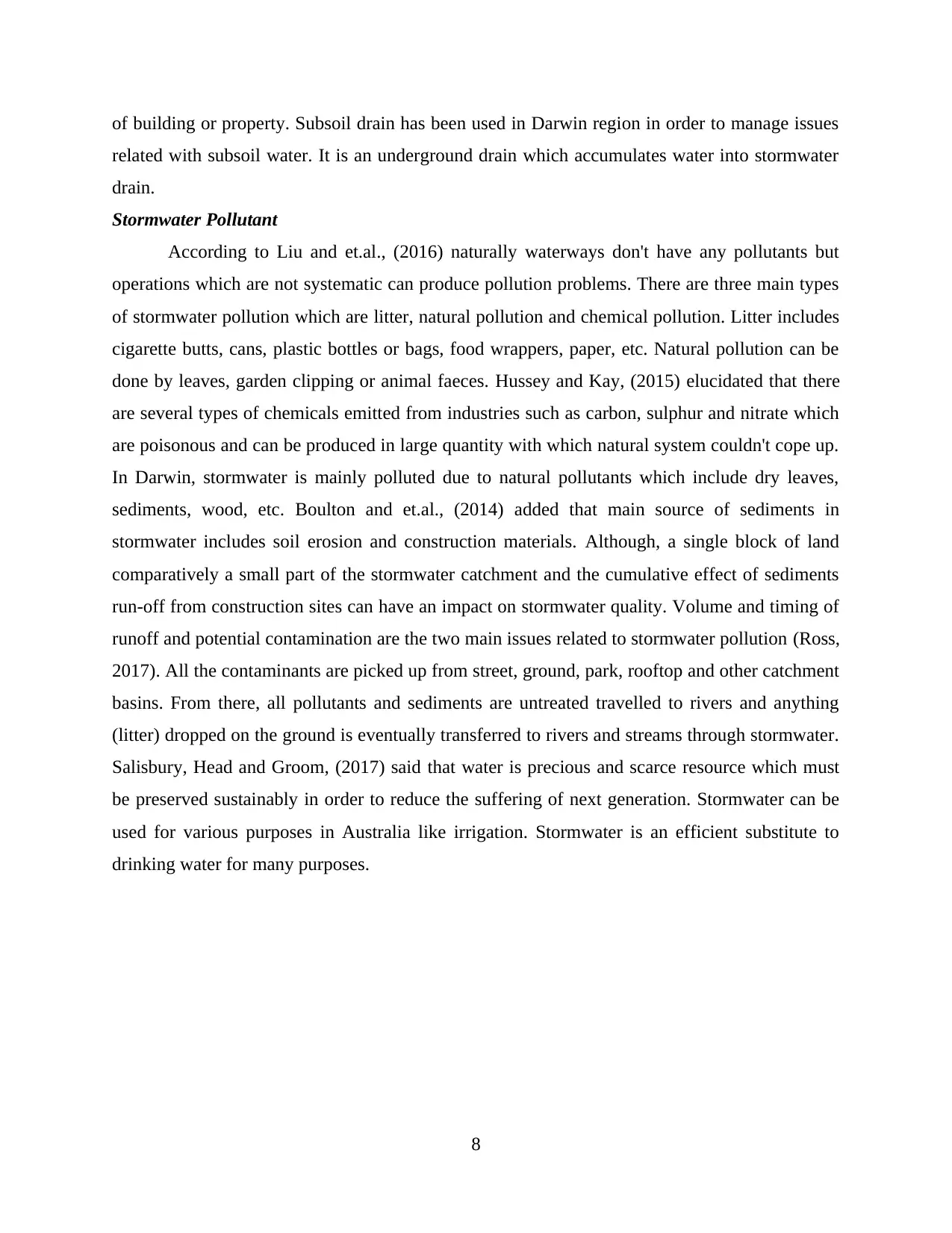
of building or property. Subsoil drain has been used in Darwin region in order to manage issues
related with subsoil water. It is an underground drain which accumulates water into stormwater
drain.
Stormwater Pollutant
According to Liu and et.al., (2016) naturally waterways don't have any pollutants but
operations which are not systematic can produce pollution problems. There are three main types
of stormwater pollution which are litter, natural pollution and chemical pollution. Litter includes
cigarette butts, cans, plastic bottles or bags, food wrappers, paper, etc. Natural pollution can be
done by leaves, garden clipping or animal faeces. Hussey and Kay, (2015) elucidated that there
are several types of chemicals emitted from industries such as carbon, sulphur and nitrate which
are poisonous and can be produced in large quantity with which natural system couldn't cope up.
In Darwin, stormwater is mainly polluted due to natural pollutants which include dry leaves,
sediments, wood, etc. Boulton and et.al., (2014) added that main source of sediments in
stormwater includes soil erosion and construction materials. Although, a single block of land
comparatively a small part of the stormwater catchment and the cumulative effect of sediments
run-off from construction sites can have an impact on stormwater quality. Volume and timing of
runoff and potential contamination are the two main issues related to stormwater pollution (Ross,
2017). All the contaminants are picked up from street, ground, park, rooftop and other catchment
basins. From there, all pollutants and sediments are untreated travelled to rivers and anything
(litter) dropped on the ground is eventually transferred to rivers and streams through stormwater.
Salisbury, Head and Groom, (2017) said that water is precious and scarce resource which must
be preserved sustainably in order to reduce the suffering of next generation. Stormwater can be
used for various purposes in Australia like irrigation. Stormwater is an efficient substitute to
drinking water for many purposes.
8
related with subsoil water. It is an underground drain which accumulates water into stormwater
drain.
Stormwater Pollutant
According to Liu and et.al., (2016) naturally waterways don't have any pollutants but
operations which are not systematic can produce pollution problems. There are three main types
of stormwater pollution which are litter, natural pollution and chemical pollution. Litter includes
cigarette butts, cans, plastic bottles or bags, food wrappers, paper, etc. Natural pollution can be
done by leaves, garden clipping or animal faeces. Hussey and Kay, (2015) elucidated that there
are several types of chemicals emitted from industries such as carbon, sulphur and nitrate which
are poisonous and can be produced in large quantity with which natural system couldn't cope up.
In Darwin, stormwater is mainly polluted due to natural pollutants which include dry leaves,
sediments, wood, etc. Boulton and et.al., (2014) added that main source of sediments in
stormwater includes soil erosion and construction materials. Although, a single block of land
comparatively a small part of the stormwater catchment and the cumulative effect of sediments
run-off from construction sites can have an impact on stormwater quality. Volume and timing of
runoff and potential contamination are the two main issues related to stormwater pollution (Ross,
2017). All the contaminants are picked up from street, ground, park, rooftop and other catchment
basins. From there, all pollutants and sediments are untreated travelled to rivers and anything
(litter) dropped on the ground is eventually transferred to rivers and streams through stormwater.
Salisbury, Head and Groom, (2017) said that water is precious and scarce resource which must
be preserved sustainably in order to reduce the suffering of next generation. Stormwater can be
used for various purposes in Australia like irrigation. Stormwater is an efficient substitute to
drinking water for many purposes.
8
Paraphrase This Document
Need a fresh take? Get an instant paraphrase of this document with our AI Paraphraser
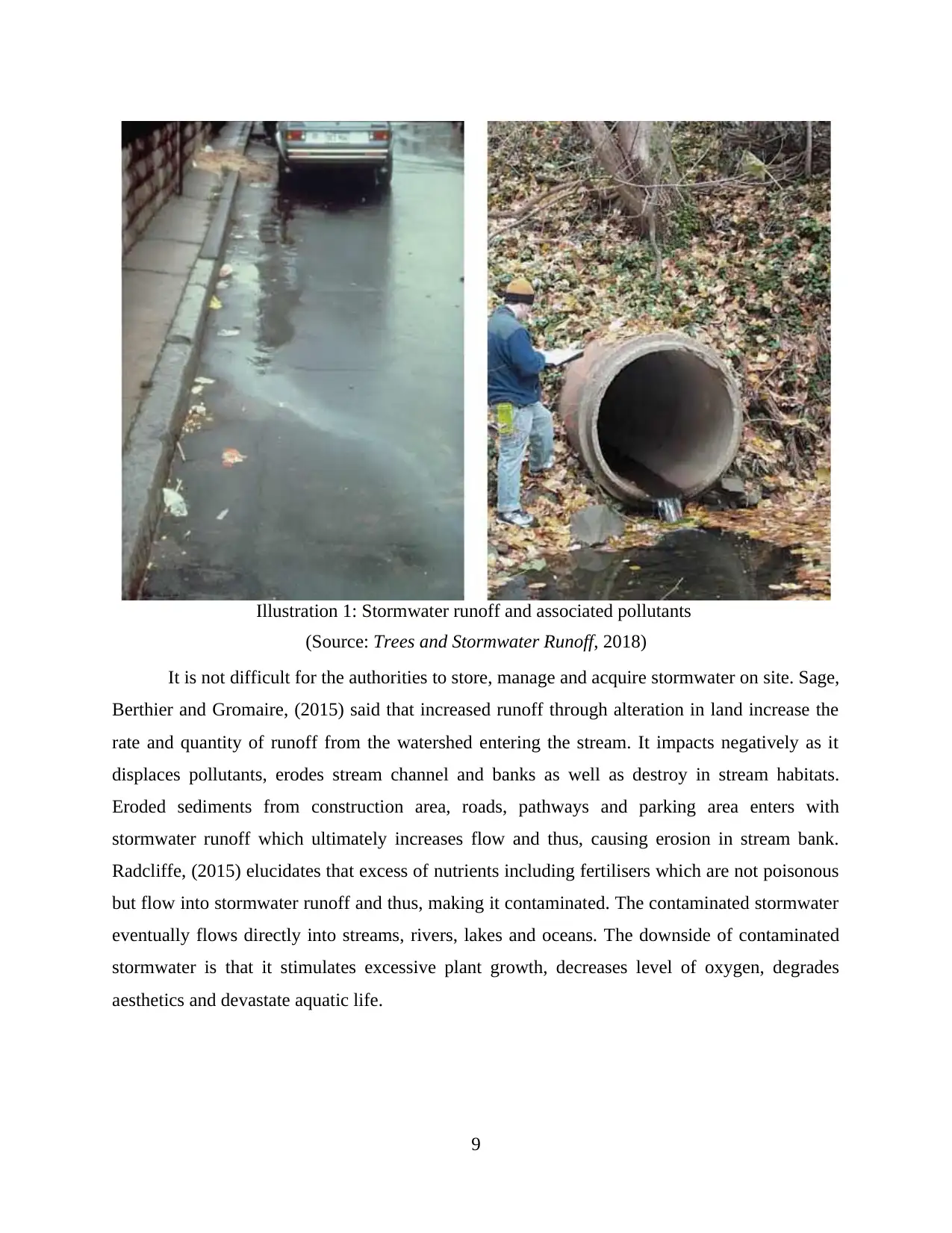
It is not difficult for the authorities to store, manage and acquire stormwater on site. Sage,
Berthier and Gromaire, (2015) said that increased runoff through alteration in land increase the
rate and quantity of runoff from the watershed entering the stream. It impacts negatively as it
displaces pollutants, erodes stream channel and banks as well as destroy in stream habitats.
Eroded sediments from construction area, roads, pathways and parking area enters with
stormwater runoff which ultimately increases flow and thus, causing erosion in stream bank.
Radcliffe, (2015) elucidates that excess of nutrients including fertilisers which are not poisonous
but flow into stormwater runoff and thus, making it contaminated. The contaminated stormwater
eventually flows directly into streams, rivers, lakes and oceans. The downside of contaminated
stormwater is that it stimulates excessive plant growth, decreases level of oxygen, degrades
aesthetics and devastate aquatic life.
9
Illustration 1: Stormwater runoff and associated pollutants
(Source: Trees and Stormwater Runoff, 2018)
Berthier and Gromaire, (2015) said that increased runoff through alteration in land increase the
rate and quantity of runoff from the watershed entering the stream. It impacts negatively as it
displaces pollutants, erodes stream channel and banks as well as destroy in stream habitats.
Eroded sediments from construction area, roads, pathways and parking area enters with
stormwater runoff which ultimately increases flow and thus, causing erosion in stream bank.
Radcliffe, (2015) elucidates that excess of nutrients including fertilisers which are not poisonous
but flow into stormwater runoff and thus, making it contaminated. The contaminated stormwater
eventually flows directly into streams, rivers, lakes and oceans. The downside of contaminated
stormwater is that it stimulates excessive plant growth, decreases level of oxygen, degrades
aesthetics and devastate aquatic life.
9
Illustration 1: Stormwater runoff and associated pollutants
(Source: Trees and Stormwater Runoff, 2018)
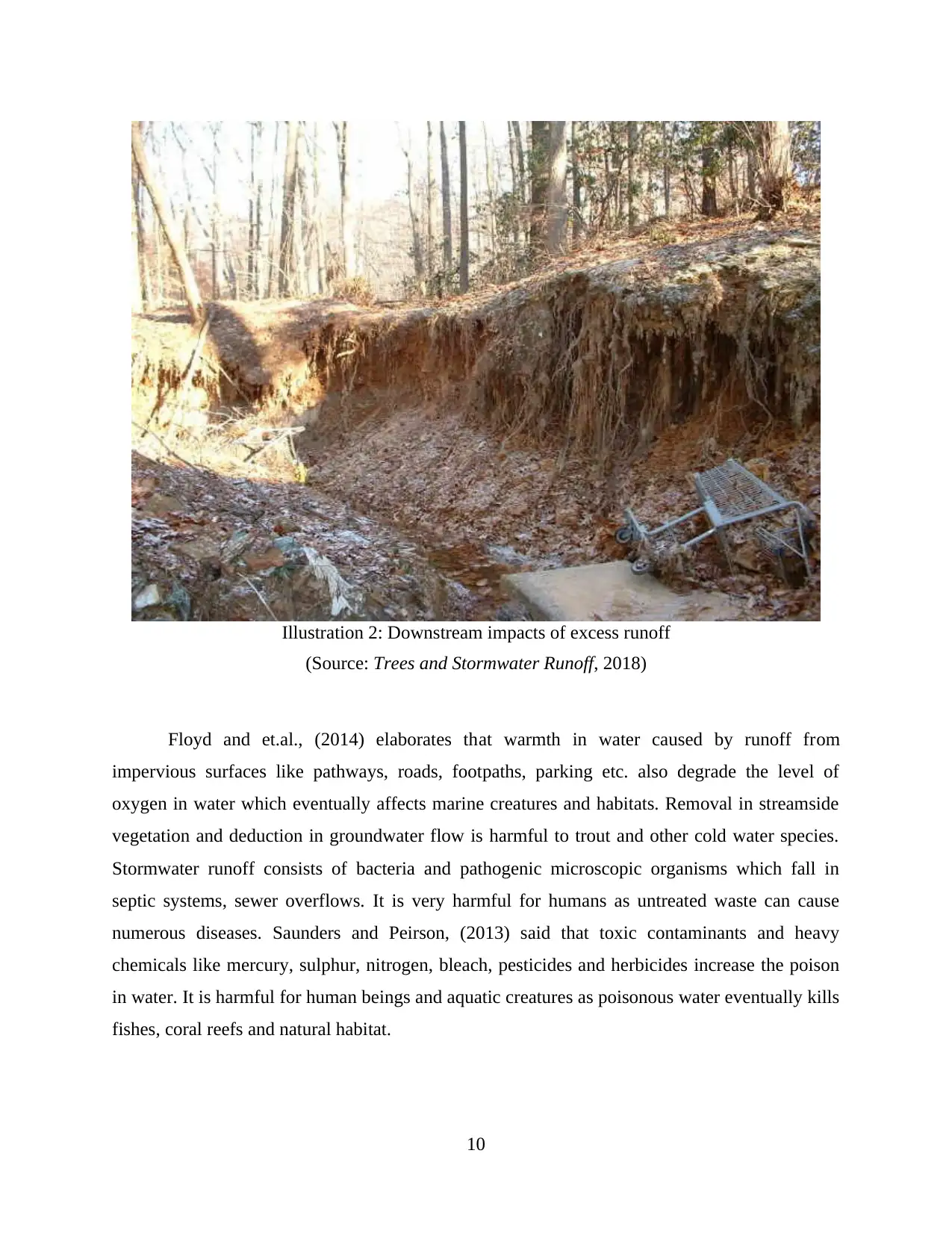
Floyd and et.al., (2014) elaborates that warmth in water caused by runoff from
impervious surfaces like pathways, roads, footpaths, parking etc. also degrade the level of
oxygen in water which eventually affects marine creatures and habitats. Removal in streamside
vegetation and deduction in groundwater flow is harmful to trout and other cold water species.
Stormwater runoff consists of bacteria and pathogenic microscopic organisms which fall in
septic systems, sewer overflows. It is very harmful for humans as untreated waste can cause
numerous diseases. Saunders and Peirson, (2013) said that toxic contaminants and heavy
chemicals like mercury, sulphur, nitrogen, bleach, pesticides and herbicides increase the poison
in water. It is harmful for human beings and aquatic creatures as poisonous water eventually kills
fishes, coral reefs and natural habitat.
10
Illustration 2: Downstream impacts of excess runoff
(Source: Trees and Stormwater Runoff, 2018)
impervious surfaces like pathways, roads, footpaths, parking etc. also degrade the level of
oxygen in water which eventually affects marine creatures and habitats. Removal in streamside
vegetation and deduction in groundwater flow is harmful to trout and other cold water species.
Stormwater runoff consists of bacteria and pathogenic microscopic organisms which fall in
septic systems, sewer overflows. It is very harmful for humans as untreated waste can cause
numerous diseases. Saunders and Peirson, (2013) said that toxic contaminants and heavy
chemicals like mercury, sulphur, nitrogen, bleach, pesticides and herbicides increase the poison
in water. It is harmful for human beings and aquatic creatures as poisonous water eventually kills
fishes, coral reefs and natural habitat.
10
Illustration 2: Downstream impacts of excess runoff
(Source: Trees and Stormwater Runoff, 2018)
⊘ This is a preview!⊘
Do you want full access?
Subscribe today to unlock all pages.

Trusted by 1+ million students worldwide
1 out of 35
Your All-in-One AI-Powered Toolkit for Academic Success.
+13062052269
info@desklib.com
Available 24*7 on WhatsApp / Email
![[object Object]](/_next/static/media/star-bottom.7253800d.svg)
Unlock your academic potential
Copyright © 2020–2025 A2Z Services. All Rights Reserved. Developed and managed by ZUCOL.

